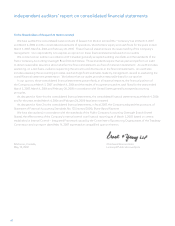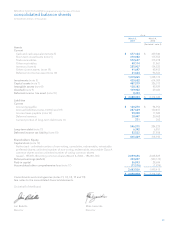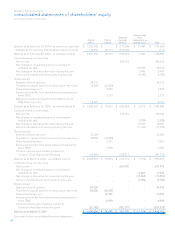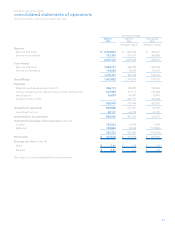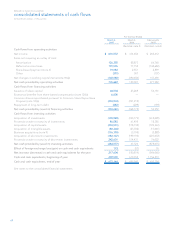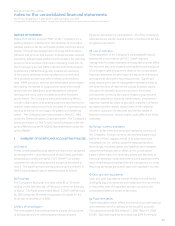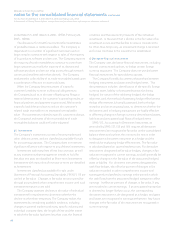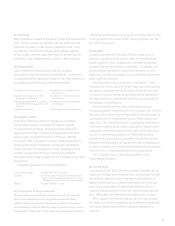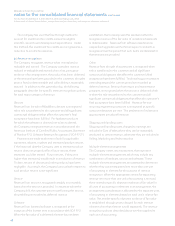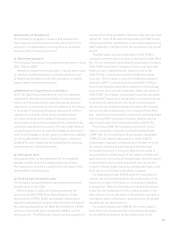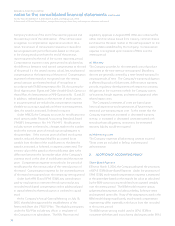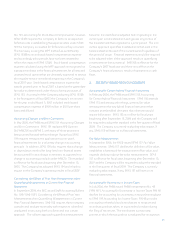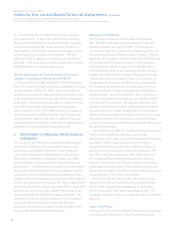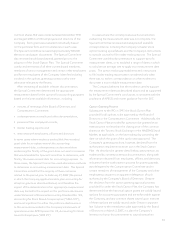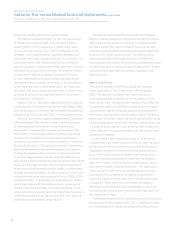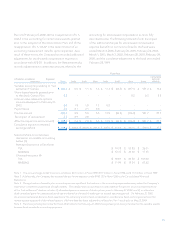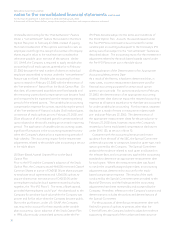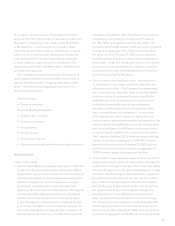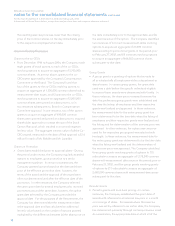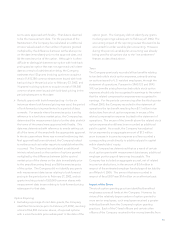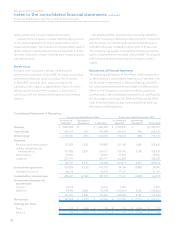Blackberry 2007 Annual Report Download - page 72
Download and view the complete annual report
Please find page 72 of the 2007 Blackberry annual report below. You can navigate through the pages in the report by either clicking on the pages listed below, or by using the keyword search tool below to find specific information within the annual report.70
RESEARCH IN MOTION LIMITED
notes to the consolidated financial statements continued
For the Years Ended March 3, 2007, March 4, 2006 and February 26, 2005
In thousands of United States dollars, except share and per share data, and except as otherwise indicated
Company’s stock as of the end of the reporting period and
the exercise price of the stock option. If the intrinsic value
is negative, no compensation expense is recorded. As a
result, the amount of compensation expense or benefit to
be recognized each period fluctuates based on changes
in the closing stock price from the end of the previous
reporting period to the end of the current reporting period.
Compensation expense in any given period is calculated as
the difference between total earned compensation at the end
of the period (i.e. the vested intrinsic value), less total earned
compensation at the beginning of the period. Compensation
expense for these awards is recognized over the vesting
period using an accelerated method of recognition in
accordance with FASB Interpretation No. 28, Accounting for
Stock Appreciation Rights and Other Variable Stock Option or
Award Plan, An Interpretation of APB Opinions No. 15 and 25.
In addition, realized gains on the exercise of stock options
in any given period are included as compensation expense.
Variable accounting is applied until there is a measurement
date, the award is exercised, forfeited or expires.
Under APB 25, the Company accounts for modifications to
stock options under Financial Accounting Standards Board
(“FASB”) Interpretation No. 44 (”FIN 44”). Modifications
include, but are not limited to, changes made to the number
and/or the exercise price of a stock option subsequent to
the grant date. If the exercise price of a fixed stock option
award is reduced, the award shall be accounted for as
variable from the date of the modification to the date the
award is exercised, is forfeited, or expires unexercised. The
intrinsic value of the award on the modification date is the
difference between the fair market value of the Company’s
common stock on the date of modification and the exercise
price. Compensation expense is recorded in the period of
modification for the intrinsic value of the vested portion of
the award. Compensation expense for the unvested portion
of the award is recognized over the remaining vesting period.
Under both APB 25 and SFAS 123(R), any consideration
paid by employees on exercise of stock options plus any
recorded stock based compensation within additional paid-
in capital related to that stock option is credited to capital
stock.
At the Company’s Annual General Meeting on July 18,
2005, shareholders approved the establishment of the
Restricted Share Unit (“RSU”) Plan. The eligible participants
under the RSU Plan include any officer or employee of
the Company or its subsidiaries. The RSU Plan received
regulatory approval in August 2005. RSUs are redeemed for
either common shares issued from treasury, common shares
purchased on the open market or the cash equivalent on the
vesting dates established by the Company. Compensation
expense is recognized upon issuance of RSUs over the
vesting period.
(v) Warranty
The Company provides for the estimated costs of product
warranties at the time revenue is recognized. BlackBerry
devices are generally covered by a time-limited warranty for
varying periods of time. The Company’s warranty obligation
is affected by product failure rates, differences in warranty
periods, regulatory developments with respect to warranty
obligations in the countries in which the Company carries
on business, freight expense, and material usage and other
related repair costs.
The Company’s estimates of costs are based upon
historical experience and expectations of future return
rates and unit warranty repair cost. To the extent that the
Company experiences increased or decreased warranty
activity, or increased or decreased costs associated with
servicing those obligations, revisions to the estimated
warranty liability would be required.
(w) Advertising costs
The Company expenses all advertising costs as incurred.
These costs are included in Selling, marketing and
administration.
2. ADOPTION OF ACCOUNTING POLICY
Share-Based Payment
Effective March 5, 2006, the Company adopted the provisions
of SFAS 123(R) Share-Based Payment. Under the provisions of
SFAS 123(R), stock-based compensation expense is estimated
at the grant date based on the award’s fair value as calculated
by the BSM option-pricing model and is recognized rateably
over the vesting period. The BSM model requires various
judgmental assumptions including volatility, forfeiture rates
and expected option life. If any of the assumptions used in the
BSM model change significantly, stock-based compensation
expense may differ materially in the future from that recorded
in the current period.
The BSM option-pricing model used in SFAS 123(R) is
consistent with that used in pro forma disclosures under SFAS


